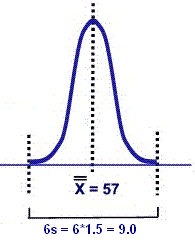Definition
A measure of process capability (potential of the process to meet specifications). Cp is the ratio of the tolerance of a process distribution to its six-sigma spread. The process must be stable (in control) in order to assess Cp. Cp is calculated without accounting for the centering of the process and uses the estimated standard deviation for sigma.
Examples

Cp is calculated as: (USL - LSL)/6s
Where USL and LSL are the upper and lower specification limits respectively and 's' is the process standard deviation estimated by dividing the average range (Rbar) of the subgroups by the appropriate SPC (statistical process control) constant, d2, which is based on the subgroup size. In other words, s = Rbar/d2.
Consider an example:
The Lower Specification Limit is 48
The Upper Specification Limit is 60
Therefore, the Tolerance is 60 - 48, or 12
The std. dev is estimated to be 1.5
Thus, the 6-Sigma process spread is 9.
Therefore, the Cp is 12/9 or 1.33.
Application
Capability analysis is performed when it is necessary to understand the potential of a process to meet customer requirements. Cp helps compare the voice of the process with the voice of the customer, without regard to the centering of the process. If the process spread is wider than the tolerance, Cp < 1.0. If the process spread equals the tolerance, Cp = 1.0. If the process spread is smaller than the tolerance with room to spare, Cp > 1.0. The example above illustrates the last case, indicating that the process is capable. However, this may be misleading, as shown by the discussion on Cpk (next).
